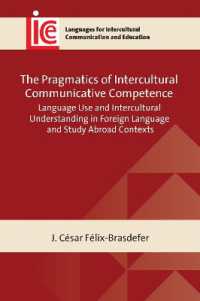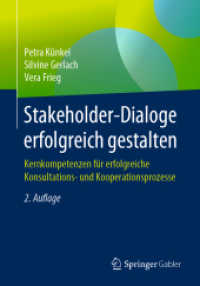- ホーム
- > 洋書
- > 英文書
- > Juvenile Grades 7-9
Full Description
Journeys to school are important time and space transitions between homes and schools for children worldwide. This book comprises various chapters providing insights into children's experiences of this essential aspect of their lives and schooling experience. From an interdisciplinary and intercultural perspective, leading international scholars focus on how children from very different contexts travel between their homes and their schools and how this transitional space impacts their daily lives and interactions with their environment. The way to and from school becomes a third place for some children who develop meaningful social and environmental relationships, mix up with children who belong to different groups, learn, relax, and so on. Studies from a wide range of disciplines and using different methods have highlighted benefits and risks related to children's journey to school, providing insightful data regarding modes of transportation, health and wellbeing issues, school organisation and legislation, safety or urban development, and so on.
Contents
Introduction; Part I. Theories And Methods to Explore the School Journey, Chapter 1. The Multidimensionality of the Way to and from School: A Third Place for Children?; Chapter 2. Walking through Mundane Landscapes: Children's Experience of Place during the School Journey; Chapter 3. Dangers in the Third Place: Walking, Public Transport and the Experiences of Young Girls in Cape Town and Abuja; Chapter 4. The (Im)Possibility of Spatial Autonomy for Young City Dwellers; Chapter 5. The Quality of the Way to School Lies in the Design Details; Part II. Children's Experiences of The School Journey Chapter 6. Children's Experiences and Affective Connections with Place in Their Independent Mobility; Chapter 7. Parental Concerns and Perceptions Related to Children's Independent Travel to School: A Case Study in Germany; Chapter 8. How Does Families' Daily Mobility between Home and School Change with the Trottibus, a Walking School Bus Program in Quebec, Canada?; Chapter 9. The Spatial Distribution of the Walking School Bus: An Interactionist Approach; Chapter 10. Incorporating the Extended Theory of Planned Behaviour in a School Travel Mode Choice Model: A Case Study of Shaoxing; Chapter 11. Thinking about Ableism and Third Place to Understand and Improve the School Journeys of Disabled Children and Their Families; Index








